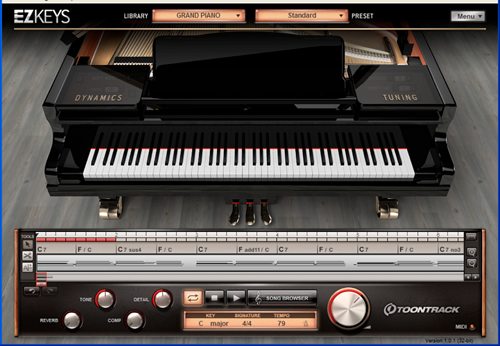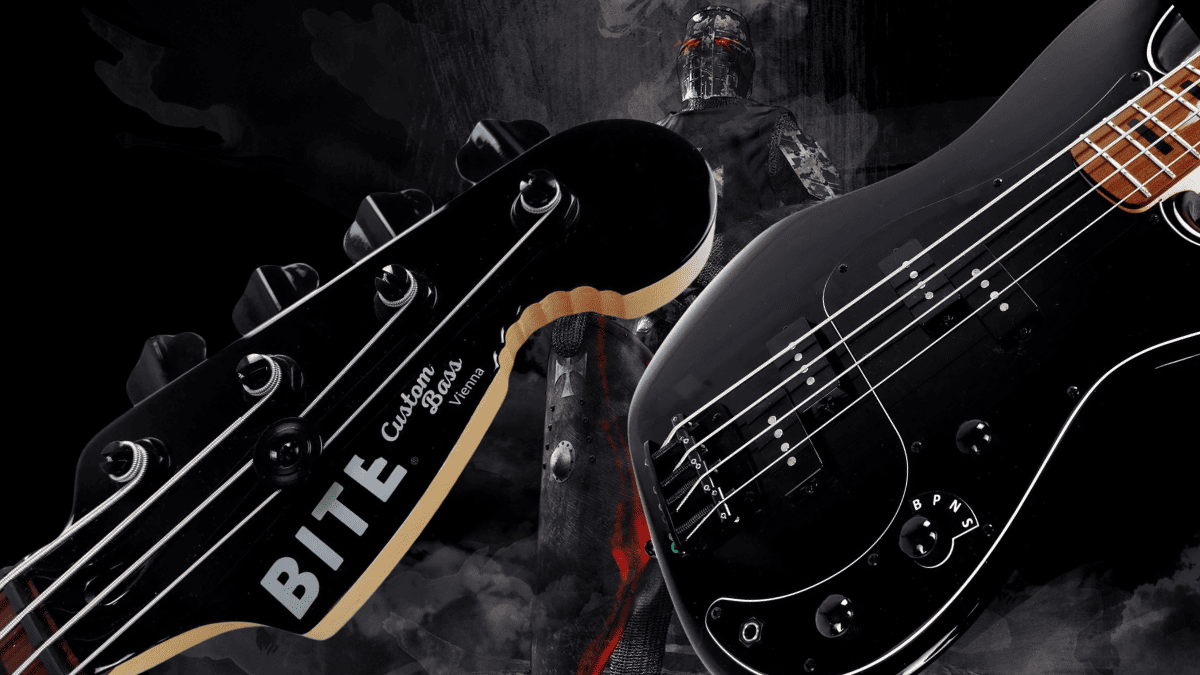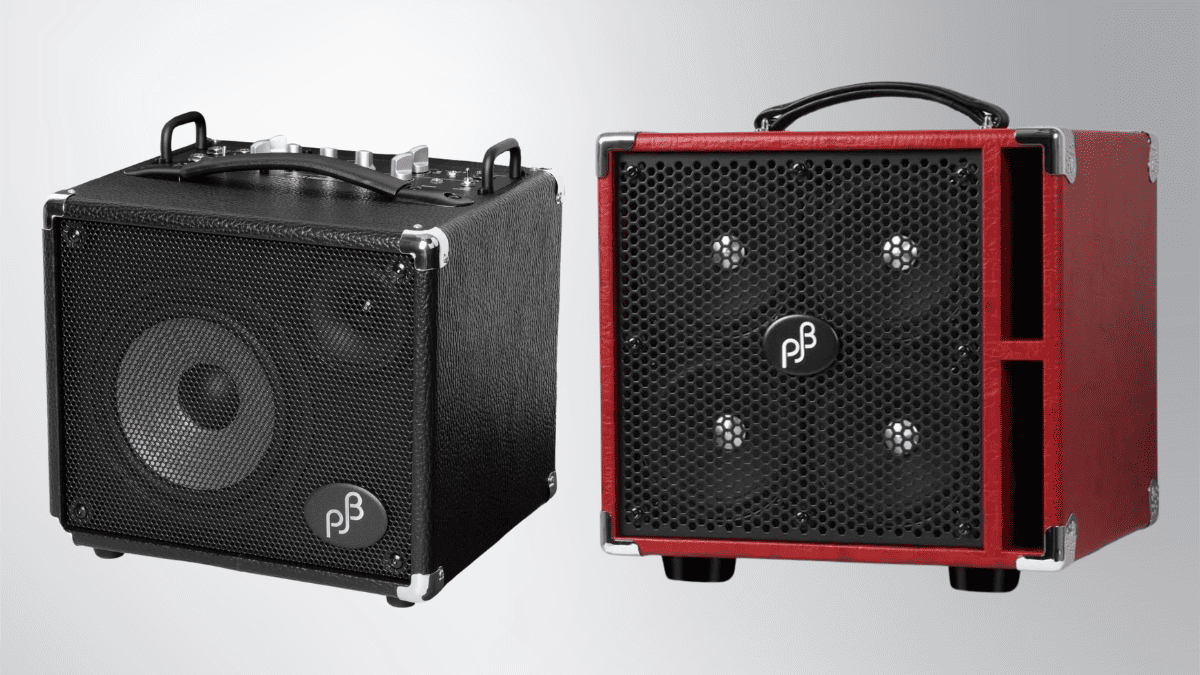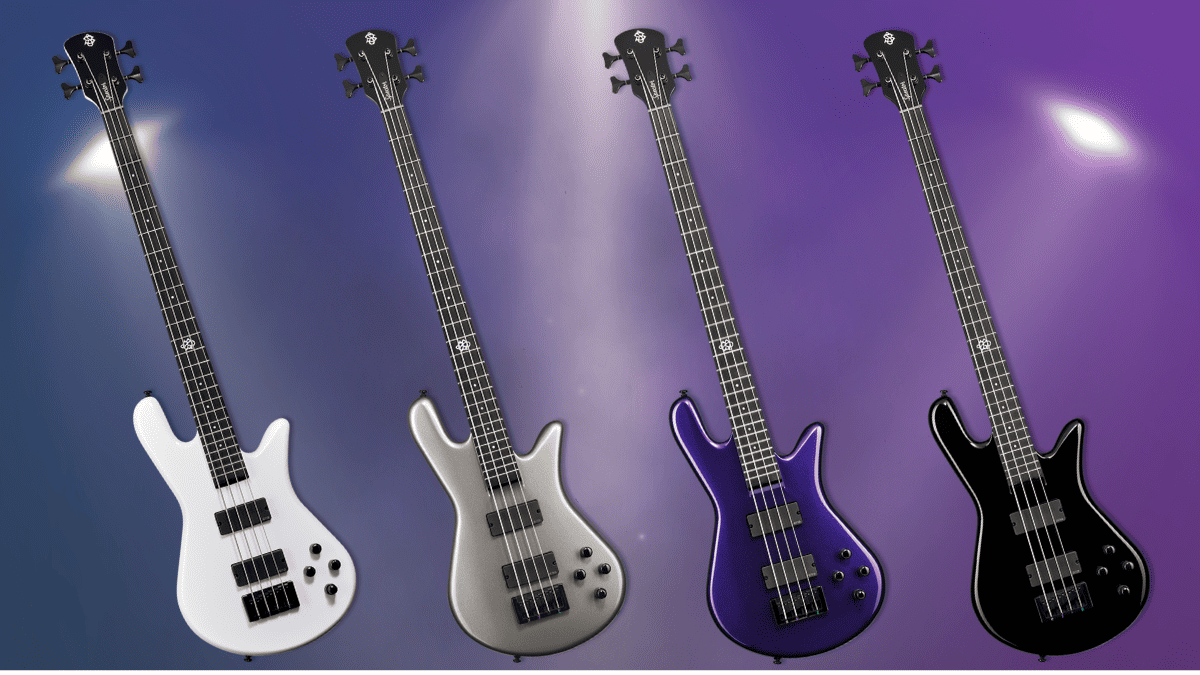Gear Reviews
EZKeys by Eric Parsons

EZKeys by Eric Parsons… EZKeys, by Toontrack, is a virtual instrument that combines a digitally sampled Steinway D concert grand piano with a variety of songwriting and compositional tools.
System Requirements, Installation and Registration
EZKeys requires:
- Windows XP SP3 or newer, Pentium IV/Athlon 1.8 with 1 GB RAM
(32 and 64-bit versions are supported as per host application)
- Max OS X 10.5 or higher, G5 or Intel processor with 1 GB RAM
(32 and 64-bit hosts are supported on the Mac Intel platform)
An Audio Unit, VST or RTAS host application and a professional sound card are recommended. The installation and registration went smoothly with no hiccups. Toontrack does require the user to enter both a serial number and a computer ID number, after which you are provided with an authorization code to finalize the process. If you get confused, just refer to the included manual.
Layout
EZKeys will work as either a standalone or loaded in your DAW as a virtual instrument. The initial graphical interface is quite attractive, consisting of the keyboard portion of a classical piano on the top half and a song track section on the bottom half of the window.
There are fourteen different sound library presets available, but to be honest, I found the standard sampled piano to be the most useful for my purposes. There are also four controls that allow you to adjust a number of parameters, which vary depending on the selected preset. The standard preset provides adjustments for reverb, tone, compression and detail settings.
The Song Browser
The song browser contains a collection of midi files that are grouped under nine different musical genres: Pop/Rock, Soul/RNB, Country, Gospel, Jazz, Latin, Blues, Boogie, and Funk with two additional categories for Basic Chords and FX and Endings. Many of the genres contain subcategories for straight or swing and/or 4/4 or 6/8 time signatures. Each subcategory is further divided into song types based on stylistic and tempo differences which are then further categorized as an intro, verse, pre chorus, chorus, or bridge. You can browse and audition the files in the browser or drag and drop the file into the Song Track and play it there. For convenience you can also drag a copy of any file to “My Favorites” for easy access at a later date.
The Song Track
MIDI files can either be brought into the Song Track via drop and drag from the midi browser or imported in from any available source. Once a MIDI file is placed in the Song Track, EZKeys analyzes the data and display a chord symbol above each cord change in the chord block. EZKeys provides several tools for copying, pasting, and adding or deleting either a selected chord or the entire song block. Right clicking on the block and selecting properties allows you to change the key, octave and velocity of the block. On a more granular level, left clicking on any of the chord symbols will call up the Chord Selector, which provides for an even wider variety of editing capabilities.
The Chord Selector
The Chord Selector allows you to easily and sensibly alter the harmonic structure of the chord. The Chord Selector is based upon the concept of the Circle of Fifths, which is a fundamental music theory tool for displaying musical relationships.
(Note: Toontrack has included an additional 26-page document on music theory for anyone seeking more knowledge on this subject.)
When using the Chord Selector, it is important to verify that the correct key has been selected for the song. EZKeys will perform this task for you when you import a midi file, but I found the process just a little bit ambiguous to my way of thinking – it may make complete sense to everyone else. After importing a midi file, EZKeys will ask, “Transpose MIDI file to project key signature?” Your choices are either:
- Don’t change
or
- Transpose
This seems simple enough, but the default key for EZKeys is “C” – so if you select “Don’t change” the MIDI file will import with no changes, but EZKeys will assume that the song is in the Key of C and the Chord Selector will display harmonic options accordingly. I found it best to import the song in this manner and to note the first chord and then to remove the song block and re-import the MIDI file and then select “Transpose”. After the MIDI file is again imported, you can then change the song block to the appropriate key so that the first chord matches up with the original noted chord and you are good to go. (It would be nice if Toontrack to offered the option of having the song block key automatically update and not stay on the default key of C when importing).
Once the key is correctly set the Chord Selector is ready to use. The Chord Selector does two very powerful things: (1) it allows you to choose chords from a selection of six related chords that are appropriate for the key of the song and (2) it also allows you to easily alter the notes and/or coloration of any given chord. For those of us with only a modicum of music theory under our belts, this is huge because we are now able to start exploring the vast new frontier of chord substitution while using the Toontrack provided training wheels of the Chord Selector to keep us from wandering too far a field.
In Use
I find EZKeys to be fascinating and fun but I will admit that I was initially quite challenged to find the exact right part for the particular song I was working on. I want to be perfectly clear on this point, the MIDI files that are included with EZKeys offer a wide range of stylistic variety and they are all performed impeccably – the issue was that my particular song did not (in my opinion) readily fit into any one of the provided genre categories. I also found it a little cumbersome that I would have to re-enter my chord progression every time I tried out a new style in the Song File. (Note: I think it would be terrific if Toontrack could figure out a way to allow for an option where the chord progression could be independent from the rhythmic portion of the MIDI file).
Success!
I then hit on a process that brought it all together. I found that once I constructed a piano part in EZKeys that was close to what I wanted, I could then import it into my DAW and really dial in the fine details using the editing tools present in the DAW. Here is a sound clip of EZKeys in action. (Click for EZKeys Soundclip) Please note that the mix is way out of whack for demonstration purposes with the keys really boosted and everything else turned down.
Final Thoughts
EZKeys is a versatile and multifaceted tool that allows those of us who are “Keyboard Challenged” to easily add professional sounding piano parts to our compositions. The utility of the Chord Selector and ease in which a piano part can be constructed, edited and auditioned makes EZKeys a valuable partner in songwriting. To learn more about EZKeys or to download the demo click here: EZKeys by Toontrack
Gear Reviews
Review Transcript: BITE Custom Bass – The Black Knight PP Bass

This is a written transcript of our video review of the BITE Custom Bass Black Knight PP Bass originally published on March 4, 2024
BITE Custom Bass – The Black Knight PP Bass Review…
Bass Musician Magazine did a review on a Steampunk bass from BITE Guitars about three years ago, it was an amazing instrument, and we were very impressed. Now we’re happy to bring you another BITE bass, the Black Knight PP.
Everybody needs a P-type bass, it’s the standard of bass. If you’re recording, they want you to have a P bass. So why not have something that gives you a little more by having two instead of one P pickup. That’s the idea of this bass, it’s the first thing that leaps out: the double P pickup configuration.
Installing two of their 1000 millivolt split-coil pickups, BITE then went one step further and wired them up in a 4-way parallel/series circuit, a look at the controls reveal a 4-way rotary selector:
The first position, marked “B”, gives you the bridge pickup by itself.
The second position, marked “P”, gives you the bridge and neck pickups in parallel mode, that’s the traditional J-type circuit, it reduces output due to the physical law of parallel circuits.
Position number 3 is marked “N”, it gives you the neck pickup by itself.
And finally, number 4, marked “S”, gives your bridge and neck in a series (humbucking) mode which adds up resistances and thus boosts output. The other two controls are master volume and master tone.
What’s more, like every BITE bass, this one also has a reinforced headstock heel designed to give it extra output and sustain. The BITE website features a graph and explanation of what they have done to the heel, as compared to traditional headstocks.
A look at the body reveals a beautiful Black Blast body finish and underneath that we have alder wood. The bass has a matching headstock with a 4-in-line tuner setup and the traditional bite out of it, so everybody will know what kind of bass you’re playing. The pickguard is 3-ply black, the neck is vintage tinted hard maple and it has a satin speed finish at the back which keeps your thumb from sticking.
On top of that, there’s a clear-coated roasted black locust fretboard with black blocks marking the frets. The nut is a black Graph Tec nut, we’ve got diamond dome control knobs, and the tuners are lightweight compacts with cloverleaf buttons and a 1:17 ratio precision gear. The bridge is a Gotoh brass bridge with 19-millimeter string spacing.
Overall measurements: we’ve got a standard 34″ scale, a 1.65″ width nut and a C neck profile. This bass weighs 8.2 pounds, or 3,7 kilograms for our metric friends, and it uses standard 18% nickel silver frets.
Taking a closer look at the sound, this bass is a joy to play. The BITE proprietary 1000 millivolt pickups deliver an extraordinary amount of output which is surprising considering this is a passive instrument. You may even want to set your amp to active mode because of all of the juice you’re getting out of this guy.
The tonal possibilities are very versatile, it’s a straight P if you want but also much more with those different arrangements of the circuitry. So why have multiple basses when you’ve got one that can give you your basic P plus a lot more?
To sum it up, the Black Knight PP is an amazing instrument. The attention to detail that BITE puts into their basses is second to none. This bass is also amazingly balanced and gorgeous to hold and feel with the satin neck finish.
For more information, visit online at bite.guitars/product/black-knight-pp
Bass Videos
Reviews: Phil Jones Bass Compact Plus 450 and Bass Engine 17

Phil Jones Bass Compact Plus 450 and Bass Engine 17 Reviews…
In this issue, we take an in-depth look at two new amps from Phil Jones Bass, the Compact Plus 450 and Bass Engine 17.
For more information, visit online at pjbworld.com
Bass Videos
Video Review: BITE Custom Bass – The Black Knight PP Bass

BITE Custom Bass – The Black Knight PP Bass Review…
I am sure many of you saw my review of the Snobby Steampunk Bass from BITE Guitars back in February of 2021 and will remember what a remarkable bass it was. BITE has been building custom basses since 2019 and has a unique custom approach where you can configure your bass to your specs.
I am very excited to have another Bass From BITE Guitars in my hands, The Black Knight PP Bass!
The need for a P-Bass in one’s armamentarium is pretty standard for bass players and I recall chatting about this with Marty O’Brien about a year ago. It turns out that Marty and BITE Guitars got together and came up with this excellent configuration that gives you a P-Bass with a whole lot more. Marty even played his own Black Knight PP bass at the 2024 NAMM show. You can see his review here.
Join me as I take an in-depth look at this very cool instrument and share all the details.
Here is The Black Knight Bass from BITE Guitars!
For more information, visit online at bite.guitars/product/black-knight-pp
Gear Reviews
Gear Review: Origin Effects Cali76 Compact Bass

Origin Effects Cali76 Compact Bass Review…
Throughout the evolution of music, bass players have sought tools to sculpt and enhance their sonic landscapes, and one indispensable ally in this pursuit has been compression. Origin Effects, a name synonymous with premium audio craftsmanship, introduces the Cali76 Compact Bass Compressor, a pedal that pays homage to the legacy of compression and brings forth a new chapter in bass sonic mastery.
As we delve into the world of the Cali76 Compact Bass Compressor, we’ll explore how Origin Effects seamlessly weaves together the heritage of compression and contemporary bass demands, promising a pedal that not only honors the past but propels your bass playing into the future. Join us on this sonic expedition as we dissect the nuances of the Cali76 Compact and uncover the secrets it holds for bass players seeking the perfect blend of vintage warmth and modern versatility.
For Starters, the Cali76 is a studio-grade FET compressor pedal, based on the classic Urei 1176, but with some features optimized for bass guitar. For those of you who are not familiar with it, a FET (Field Effect Transistor) compressor is essentially a solid-state tube compressor emulation that allows for fast and precise control over the attack and the release parameters; allows for extreme compression ratios; and finally adds the typical 1176 color and character to the sound.
Together with the common controls we see in most compressor pedals – Ratio, Attack/Release, input (just like the original 1176, the threshold in this pedal is fixed), and output (makeup gain). The Cali76 offers two more controls dedicated to us bass players.
A Dry control – This allows us to mix in our dry, uncompressed signal to the pedal output. This is great for when we want to add back some of our playing dynamics to the compressed sound or for when you want some volume back in situations where the compression starts taking away the volume.
A High Pass Filter control – Low frequencies on a bass guitar signal normally overwhelm compressors. This high pass filter allows the compressor to only react to higher frequencies, which helps preserve the natural dynamics of our playing while keeping the low end intact.
Metering on this pedal can be a bit hard to get used to at first. There’s a single LED light on the pedal, that not only serves as an On/Off light, but it’s also our meter. It glows red when no compression is applied and orange for active compression. The brighter the light, the greater the amount of gain reduction. Yellow signifies that the gain reduction reached 27dB and maximum reduction occurs around 38 dB.
In practical terms, it’s all about working with the input and the LED to find the sweet spot (turn the input to zero, start playing and slowly increase the input level until you start seeing the LED glowing orange, which means there’s reduction going on).
With 6 highly interactive knob controls, this pedal implies some degree of compressor knowledge and also some amount of tweaking and experimentation to find the perfect settings. The good news is that it is very hard to make this pedal sound bad…
It can go from very subtle compression settings to very extreme, and it can do everything in between. Also, the team at Origin has been kind enough to add a couple of sample settings in the manual to get players started and to help us understand better how the pedal works.
Dynamic Control is a setting that provides natural compression, balancing dynamics between various playing techniques. It is a subtle compression that will work almost out of the box almost all the time. Having a medium setting for the High Pass Filter ensures an honest translation of the lower string dynamics.
Parallel compression is a popular studio technique, where both compressed and natural signals are blended. We get the sound and feel of hard compression while retaining the natural playing dynamics.
Percussive, lively & Fat is a setting that uses a slower attack time to accentuate the start of any note. Then using a fast release allows the compressor to recover between notes so that the phrases sound more percussive. Ideal for slapping and other percussive techniques.
Finally, I would like to mention the classic 1176 tonal coloration. It’s not a secret that engineers all around would sometimes use the 1176 compressor, without applying any compression, just to get the tonal coloration into the instrument sound.
And the Cali76 compressor is no different, it has such a rich, warm, and full coloration that’s super pleasing to the ear and makes you want to have it ON all the time. So be aware, that if you want a transparent compressor, this pedal is not for you!
All in all, it is easy to understand why this pedal became a favorite of so many bass players around the world. The Cali76 Compact stands as a testament to the meticulous craftsmanship and thoughtful engineering that Origin Effects is renowned for. It seamlessly navigates through the rich history of compression, offering bass players a gateway to the soulful resonance of the past while empowering them to sculpt a contemporary sonic future.
Whether you’re a seasoned bass maestro or a budding virtuoso, the Cali76 Compact invites you to embark on a sonic journey where every note is held in a delicate balance between tradition and innovation. As we bid farewell to our exploration, we do so with the realization that the Cali76 Compact is more than just a pedal; it’s a sonic companion that elevates the artistry of bass playing
For more information, visit online at origineffects.com
Gear Reviews
Spector NS Ethos HP 4 Bass Review

Spector NS Ethos HP 4 Bass Review…
Not long ago, I did a review of the Spector NS Dimension HP 5 Bass and I have just been given the honor and privilege of reviewing the Spector NS Ethos HP 4 Bass. I have to say, another great bass from Spector that is hard to put down! While there are some similarities between both basses, there are also some noticeable differences which is why I believe having both is essential to any bass arsenal.
Spector, widely used by many rock and metal bassists like Ian Hill, Alex Webster, Colin Edwin, Doug Wimbish, and many more, just to name a few, has a long-standing in these genres. Well, that’s about to change! The bass I used for the review, didn’t see any of those genres, matter of fact, I used it on a few classic country gigs and at church too! However, when at home in the studio, I let the funk out. The NS Ethos HP 4 Bass is an all-around great bass for any genre and will not disappoint.
Let’s get into the specs about the bass, and here we will find the differences between the HP 5 Bass and the HP 4.
Forget that one is a 5 string, while the other is a 4, while that is a difference, that’s not one that I feel needs to be noted as both models are available as 4 and 5 strings. The Spector NS Ethos HP 4 Bass has a 34” scale, 24 fret, 3 piece maple neck through construction with solid alder wings, ebony fingerboard along with centered and side dots and the 12th fret Spector logo inlay with a brass nut.
While the pickups are different as the NS Dimension HP 5 Bass uses the EMG 45DC and the NS Ethos HP 4 Bass sports the EMG 35DC pickups, they are the same pickup configurations, the difference being, one for 4 string, the other for 5 string. The electronics are the same, consisting of a Darkglass Tone Capsule preamp which consists of +-12dB @70Hz for Bass, +-12dB @500Hz for Mids, and +-12dB @2.8kHz for Hi Mids. Controls for Spector NS Dimension HP 5 Bass consist of Master Volume, Blend, Bass, Mid, and Hi Mid controls. The electronics are powered by a 9-volt battery.
The bridge is a Hi-Mass locking bridge with intonation screws and the tuners are sealed die-cast. All hardware is black. Same as the Spector NS Dimension HP 5 Bass, the HP 4 Bass is available in 4 different finishes, White Sparkle Gloss, Gunmetal Gloss, Plum Crazy Gloss & Black Gloss. The bass also comes with a very nice and well-padded gig bag.
Check out the Spector NS Ethos HP 4 Bass at a Spector Music Retailer today near you or visit online at spectorbass.com/product/ns-ethos-hp-4/






























